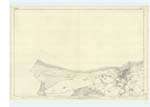OS1/22/6/23
| List of names as written | Various modes of spelling | Authorities for spelling | Situation | Description remarks |
|---|---|---|---|---|
| KEBBUCK STONE (Sculptured) | Kebbuck Stone (Sculptured) Kebbuck Stone (Sculptured) Kebbuck Stone (Sculptured) Kebbock Stone Cabbac Stone |
William A Stables Esqr. Factor, Cawdor Mr George Cuthbert, Castle Delnies Mr. Peter Mackenzie, Newlands of Delnies New Statistical Account Fulleraton's Gazetteer |
001 | The "Kebbuck Stone" is a rough standing slab of grey Sandstone; greatest height 6 feet, extreme breadth 4 ft 2 inches; varying in thickness from 14 to 9 inches thickest and in ground, the Stone leans from the upright 9 inches northwards. The west of Inverness-shire face is smooth, having evidently been the bed of the Stone while yet it lay in its quarry; the artificial markings on this face consist of a circular figure 16¼ by 15½ inches, from which branch off a few lines apparently indicative of a rude Iona cross; only if so the lower half of the upright limb is now extremely effaced. The east or Nairn face is rough and dented, having on it a circle 11 inches in diameter with a cross scratched within it; to the Circle's right are various markings (one elliptic with various cuttings within it, another an obtuse angle with a hole at its lower end) having no apparent design, while to the left is a mason like mark: the circle together with the elliptic and angular figures may be ancient; but the mason like mark, the cuttings within the ellipse and the hole at the end of angle are most likely modern and the work of idle boys. There is no appearance of skilled labour about this Stone, all its markings whether ancient or modern having apparently been effected by repeated scratches with an iron point. The Kebbuck Stone stands on a little grassy hillock. Various are the local traditions regarding the origin of this Stone. 1st That the Danes used it as a mooring post for their invading Galleys; the only fact in favour of this tradition is the close proximity of the old beach line of the Moray Firth; but so far as known to the Examiner this tradition has no support from written records. 2nd That a thief having stolen a cheese (date ancient but unknown) from Inverness Market, he was here overtaken, slain and buried, and this is his monumental Stone; with the effigy of his crime, the Kebbuck - anglice cheese - scratched upon it. Fullartons Gazatteer notices this tradition Vol [Volume] 1 Page 69 it is written "Where this Parish ie. Ardersier is divided from Nairnshire, there is a stone about 6 ft [feet] high and 3 broad called the Cabbac Stone, which tradition says, was erected over a Chieftain who fell in an affray in the town of Inverness" two points militate against this tradition 1st the Stone credits the thief with stealing two Cheeses and 2nd at present the locality ignores the Chieftain rank of the slain man, calling him simply a thief to whose memory it is most unlikely the locality would ever have taken the trouble to raise such a substantial monument. 3rd A local tradition makes this a covenant stone, and George Cuthbert read about 20 years ago in an old Gazetteer of Scotland, while Peter Mackenzie read recently in a small book which he has now managed to lose and is unable to remember its title, a legend somewhat as follows - In ancient times (perhaps the books supply the date) a burn ran in the slack to the west of the Kebback Stone, this steam formed the boundary between the Lairds of Delnies and Ardersier, but rainy seasons at times changed its course, which gave rise to bickerings as to the exact boundary, ending often in feud & bloodshed. On one day the antagonistic Lairds had mustered their tenants for battle when a 3rd Laird from the West Highlands named Cameron attended by a large following appeared on the scene; demanded to be made Mediator & settled the dispute, whereon ensued peace, sealed by a feast of bread, cheese & whisky, and crowned at its close by the heretofore antagonistic tenantry raising this stone as a token of perpetual peace between their feudal lords. The Circles on the stone commemorate the respective sizes of the Kebbucks furnished by each Laird to the feast, and testify to the liberality of Ardersier in so far as cheese was concerned. |
Continued entries/extra info
County of Nairn Parish of Nairn 23Transcriber's notes
The original document describing Kebbuck Stone includes 4 sketches of which show the general appearance of the stone.Transcribers who have contributed to this page.
Kate51- Moderator, Bizzy- Moderator
Location information for this page.
Linked mapsheets.




